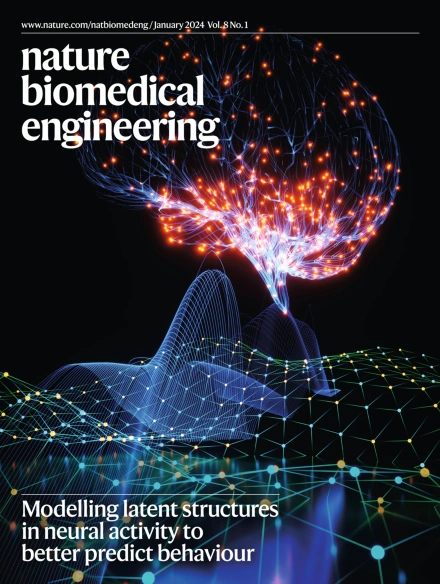Invasive neurophysiology and whole brain connectomics for neural decoding in patients with brain implants.
IF 26.8
1区 医学
Q1 ENGINEERING, BIOMEDICAL
引用次数: 0
Abstract
Brain-computer interface research can inspire closed-loop neuromodulation therapies, promising spatiotemporal precision for the treatment of brain disorders. Decoding dynamic patient states from brain signals with machine learning is required to leverage this precision, but a standardized framework for invasive brain signal decoding from neural implants does not exist. Here we develop a platform that integrates brain signal decoding with magnetic resonance imaging connectomics and demonstrate its use across 123 h of invasively recorded brain data from 73 neurosurgical patients treated with brain implants for movement disorders, depression and epilepsy. We introduce connectomics-informed movement decoders that generalize across cohorts with Parkinson's disease and epilepsy from the United States, Europe and China. We reveal network targets for emotion decoding in left prefrontal and cingulate circuits in deep brain stimulation patients with major depression. Finally, we showcase opportunities to improve seizure detection in responsive neurostimulation for epilepsy. Our study highlights the clinical use of brain signal decoding for deep brain stimulation and provides methods that allow for rapid, high-accuracy decoding for precision medicine approaches that can dynamically adapt neurotherapies in response to the individual needs of patients.脑植入患者神经解码的侵入性神经生理学和全脑连接组学研究。
脑机接口研究可以激发闭环神经调节疗法,有望实现脑疾病的时空精确治疗。利用机器学习从大脑信号中解码动态患者状态需要利用这种精度,但目前还不存在从神经植入物中解码侵入性大脑信号的标准化框架。在这里,我们开发了一个将脑信号解码与磁共振成像连接组学相结合的平台,并展示了它在73名因运动障碍、抑郁症和癫痫而接受脑部植入治疗的神经外科患者123小时的侵入性脑数据记录中的应用。我们介绍了基于连接组学的运动解码器,这些解码器适用于来自美国、欧洲和中国的帕金森病和癫痫患者。我们揭示了重度抑郁症深度脑刺激患者左前额叶和扣带回路中情绪解码的网络靶点。最后,我们展示了在癫痫反应性神经刺激中改善癫痫发作检测的机会。我们的研究强调了脑信号解码在深部脑刺激中的临床应用,并为精准医学方法提供了快速、高精度的解码方法,这些方法可以根据患者的个体需求动态调整神经疗法。
本文章由计算机程序翻译,如有差异,请以英文原文为准。
求助全文
约1分钟内获得全文
求助全文
来源期刊

Nature Biomedical Engineering
Medicine-Medicine (miscellaneous)
CiteScore
45.30
自引率
1.10%
发文量
138
期刊介绍:
Nature Biomedical Engineering is an online-only monthly journal that was launched in January 2017. It aims to publish original research, reviews, and commentary focusing on applied biomedicine and health technology. The journal targets a diverse audience, including life scientists who are involved in developing experimental or computational systems and methods to enhance our understanding of human physiology. It also covers biomedical researchers and engineers who are engaged in designing or optimizing therapies, assays, devices, or procedures for diagnosing or treating diseases. Additionally, clinicians, who make use of research outputs to evaluate patient health or administer therapy in various clinical settings and healthcare contexts, are also part of the target audience.
 求助内容:
求助内容: 应助结果提醒方式:
应助结果提醒方式:


